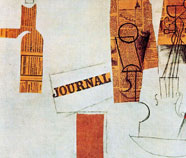

Cubism profoundly affected the Russian avant-garde, the Italian Futurists and the British Vorticists among others. Although the term Cubism usually refers to these developments of Analytic and Synthetic Cubism in early 20th century France pioneered by Picasso, Braque and others, the impact of Cubist ideas and pictorial forms reverberated throughout Europe and abroad. By creating an image that is a synthesis of pictorial elements, both real and painted, Picasso and Braque challenged the deceptive and artificial nature of illusionistic representation. The artists used collage to further challenge the viewer’s understanding of reality and representation. Cubist artists reimagined conventional representation by rejecting the traditions of perspective, modeling, and foreshortening favored during the Renaissance.

The Cubist movement consisted of two major phases: Analytic Cubism and Synthetic Cubism. This was the first Cubist collage and initiated the second major phase of Cubism termed Synthetic Cubism. Cubism is a Modern art movement that emerged around 1907 in Paris, France. Sometime in the spring of 1912 Picasso glued a piece of oilcloth printed with a tromp l'oeil chair-caning pattern to a small canvas and named it Still-life with Chair-caning. Volume was rendered in flat planes instead of using tonal modeling and three-dimensionality was indicated by showing multiple viewpoints simultaneously. During this time, Picasso, Braque, Gris, and other artists simplified their compositions and brightened their color palettes.
#Synthetic cubism series#
The early Cubist works of Picasso and Braque assaulted Renaissance ideals of perspective and illusionism by breaking up the picture surface into a series of planes, signs and shifting viewpoints. Synthetic Cubism is the movements second phase, emerging in 1912 and lasting until 1914. These initial works of Braque and Picasso comprise what art historians usually refer to as the first phase of Cubism, or Analytic Cubism. The term Cubism, however, was coined in 1908 by the French art critic Louis Vauxcelles when he described some of Georges Braque’s paintings as ‘geometric schemas and cubes’. Some scholars cite Pablo Picasso’s Les Demoiselles d’Avignon of 1907, others Georges Braque’s Houses at L’Estaque of 1908 and still others the first organized group show by Cubists in Paris in 1911 with works by Fernand Léger, Robert Delaunay, Henri Le Fauconnier, Jean Metzinger and Albert Gleizes. The exact date of the inception of Cubism is debated. Heralded as one of the most original and influential artistic movements of the 20th century, Cubism aggressively challenged Western conceptions of pictorial representation. Pablo Picasso: Three Musicians, oil on canvas, 2.01×2.23 m, 1921 (New York, Museum of Modern Art) © 2007 Estate of Pablo Picasso/Artists Rights Society (ARS), New York, photo © Museum of Modern Art/Licensed by SCALA/Art Resource, NY Public Art, Land Art, and Environmental Art Installation Art, Mixed-Media, and Assemblage

Western painting - The history of Western painting represents a continuous, though disrupted, tradition from Antiquity.Collecting, Patronage, and Display of Art Pablo Picasso, Dejeuner sur l Herbe … Wikipedia Modern art - For other uses, see Modern art (disambiguation). Across cultures, and spanning continents and… … Wikipedia The history of painting represents a continuous, though disrupted, tradition from Antiquity. History of painting - The history of painting reaches back in time to artifacts from pre historic humans, and spans all cultures. the early phase of cubism, chiefly characterized by a pronounced use of geometric shapes and by a tendency toward a monochromatic use of color. Cf.… … Useful english dictionaryĪnalytical cubism - (sometimes caps.) Fine Arts. Hypernyms: ↑cubism * * * (sometimes caps.) Fine Arts.

Also see Cubism, ersatz, fiber, nature, plastic, polymer, and resin … Glossary of Art TermsĪnalytical cubism - noun the early phase of cubism (Freq. a style of painting and sculpture developed in the early 20th century, characterized chiefly by an emphasis on formal structure, the reduction of natural forms to their… … Universalium Cubism was a 20th century avant garde art movement, pioneered by P … WikipediaĬubism - cubist, n. Considered to be a major step towards the founding of the Cubist movement. Synthetic Cubism - See … Glossary of Art TermsĬubism - Pablo Picasso, Les Demoiselles d Avignon, 1907. the late phase of cubism, characterized chiefly by an increased use of color and the imitation or introduction of a wide range of textures and material into painting. Synthetic cubism - (sometimes caps.) Fine Arts.


 0 kommentar(er)
0 kommentar(er)
